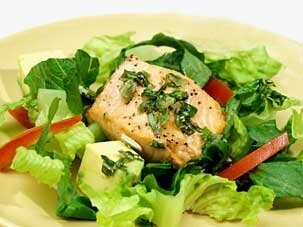If you don't know what to serve for dinner tonight ...
This is great-tasting, easy-to-prepare salmon salad with a refreshing sauce. The herbs are not only flavorful, but are also full of nutrients. Feel free to add more salad ingredients of your liking.

Ingredients:
- 3/4 lb salmon filets cut in 4 pieces
- 2 TBS chopped fresh mint
- 3 TBS chopped fresh basil
- 2 TBS chopped fresh cilantro
- 2 TBS lemon juice
- 2 TBS extra virgin olive oil
- 3 TBS chopped pumpkin seeds
- salt & pepper to taste
- 1 head romaine lettuce, rinsed and chopped
- 1 medium tomato, seeds and excess pulp removed and sliced
- 1/2 medium avocado cut into 1 inch chunks
- 2 TBS lemon juice
- extra virgin olive oil to taste
- salt & pepper to taste
- Cut salmon into 4 pieces, season with salt and pepper, place on a plate and set aside. Preheat broiler on high and put stainless steel skillet (make sure handle is also stainless) for about 10 minutes until very hot. Do not use glass or pyrex for this.
- Mix together mint, basil, cilantro, lemon juice, olive oil, chopped pumpkin seeds, salt and pepper. Set aside. This is your herb mixture.
- Prepare lettuce, tomato and avocado and toss with lemon juice, olive oil, salt and pepper.
- Remove pan from heat and place salmon on hot pan. Quick Broil salmon for about 4 minutes. Do not turn. Because pan is hot salmon will cook very quickly. Place on a plate next to salad and top with herb mixture. You will have some herb mixture left over. It is so good you may also want to drizzle it on the salad greens.
- Seafood Gazpacho
In-Depth Nutritional Profile for Broiled Salmon Salad
Healthy Food Tip
A friend told me that eating one raw navy bean per day can greatly reduce cholesterol levels. Is that true?
What you've been told by your friend is incorrect. In general, I'd encourage everyone to remember that there is no single food, or any single part of food, that works like a magic bullet in terms of health. The World's Healthiest Foods work together in a meal plan to support our health and lower our risk of most chronic diseases. But it's almost never helpful to depend on a single food in isolation from the rest of our diet.
I'd also hope that the example you gave—"one raw navy bean"—would raise immediate questions in your mind about the information your friend was providing. I'm not aware of any traditional cuisine in which raw navy beans (we assume you mean dried, uncooked beans) are eaten. And I also am not aware of anyone ever eating one single bean. A half cup of beans, or at least several tablespoons of beans on a salad would be the least amount of beans that anyone would commonly eat. Both of these factors—the idea of eating a raw, dried bean and the idea of eating only one single bean—would be factors that might raise immediate doubts about your friend's statement.
It is true that meal made from ground up, uncooked dried beans has been fed to rats in a way that has reduced their total body fat. Researchers have speculated that the mechanism connecting these two events involved substances called lectins that were present in the raw beans. They also questioned, however, the relevance of this rat study for humans, and pointed out that safety issues would be involved when considering the effects in humans since lectins are known to trigger immune system responses that can be associated with immune-related health risks. I interpret this research to mean that consumption of raw beans is still far from desirable based on existing research.
There is, however, a definite relationship between safe consumption of cooked beans and cholesterol reduction. The soluble fibers found in beans are capable of binding together with bile acids and lowering their availability in the body. Without as many available bile acids, the body cannot form micelles (complexes of bile acids and other substances) that are needed for absorption of cholesterol. Beans also contain insoluble fiber, which research studies have shown not only helps to increase stool bulk and prevent constipation, but also helps prevent digestive disorders like irritable bowel syndrome and diverticulosis.
For more information on this topic, see:
References:
Barampama Z, Simard RE. Effects of Soaking, Cooking and Fermentationon Composition, in-Vitro Starch Digestibility and Nutritive Value of Common Beans. Plant Foods Hum Nutr. 1995;48(4):349-65.
Fernandez ML. Soluble Fiber and Nondigestible Carbohydrate Effects on Plasma Lipids and Cardiovascular Risk. Curr Opin Lipidol. 2001; 12, no. 1 (2001): 35-40.
Hewitt D, Coates ME. Effects of Raw Soya-Bean and Navy-Bean Meals on Germ-Free and Conventional Chicks. Proc Nutr Soc.1969;28(2):47A-8A.
Pereira MA, Pins JJ. Dietary Fiber and Cardiovascular Disease: Experimental and Epidemiologic Advances. Curr Atheroscler Rep. 2000;2(6):494-502.
Pusztai A, Grant G, Buchan WC et al. Lipid Accumulation in Obese Zucker Rats Is Reduced by Inclusion of Raw Kidney Bean (Phaseolus Vulgaris) in the Diet. Br J Nutr. 1998;79(2):213-21.
Santidrian S, de Moya CC, Grant G, et al. Local (Gut) and Systemic Metabolism of Rats Is Altered by Consumption of Raw Bean (Phaseolus Vulgaris L Var Athropurpurea). Br J Nutr. 2003;89(3):311-9.


No comments:
Post a Comment